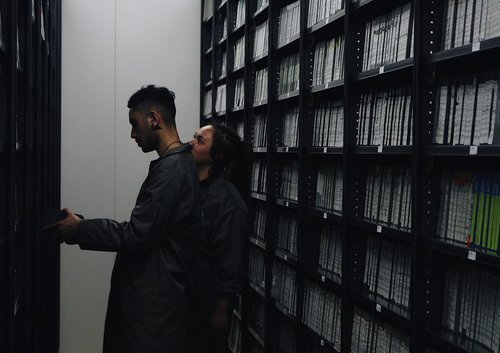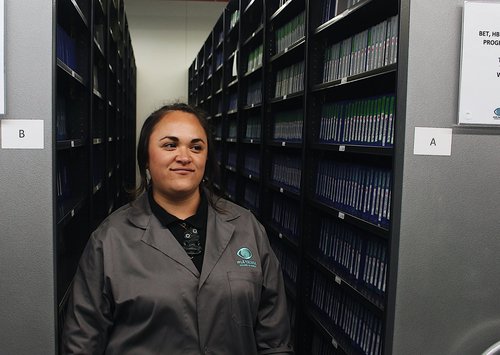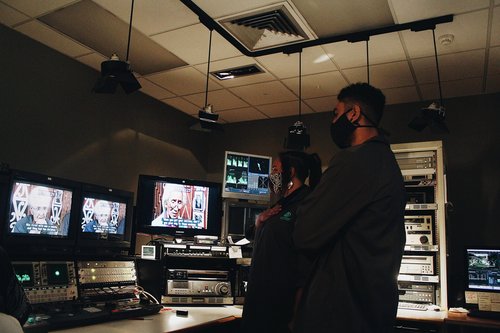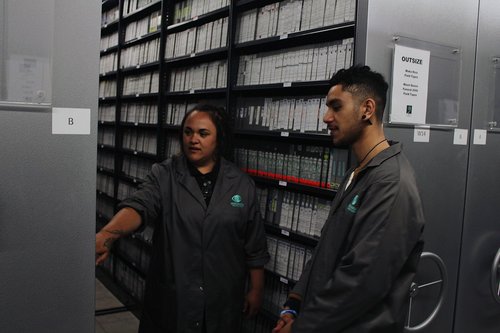
Heritage organisations like galleries, libraries, archives and museums (sometimes abbreviated to the GLAM sector) hold enormous amounts of mātauranga Māori in safekeeping. But that safekeeping can be a double-edged sword, when the people who want to access taonga don’t know where to start. Catalogues are not always easy to use, and just walking into an institution can be intimidating if you’ve never done it before. How do you find out where the item you’re looking for is being stored, or if it even exists?
Hero image: Mai and Khali select a videotape from the vault. (Photo by Renati Waaka)
Ngā Taonga Tuku Iho was produced and directed by Kahu Kutia and funded by Te Papa Tongarewa. Host Khali Meari Materoa explores some of the cultural treasures held by Aotearoa New Zealand’s museums and galleries, and demystifies some of what goes on behind the scenes for aspiring researchers. Each episode focuses on a different heritage institution, and to make Episode Three, Khali and crew visited us at Ngā Taonga. She met with Maimoa Toataua-Wallace, a Kaitohutohu Mātauranga Māori – Mātauranga Māori Outreach Advisor, who spent the day showing her around the Archive.

Khali between takes of 'Ngā Taonga Tuku Iho'. (Photo by Renati Waaka)
The following blog is by Maimoa and is about the shoot, and the taonga he and Khali shared. (Read in te reo Māori)

Maimoa and Khali at Nga Taonga. (Photo by Renati Waaka)
Ngā Taonga Tuku Iho blog by Maimoa
In order to understand the meaning of this kōrero, I have to refer back to my birth in 1998. I was born under the heels of Taranaki maunga and eventually, I would find myself in Waikato, closer to a place I will always consider a home or a stronghold – a kāinga, in Kāwhia. Now I’m here, in Te Whanganui-a-Tara as Mātauranga Māori Advisor at Ngā Taonga Sound & Vision, a space where the stories and lives of many are projected and resurfaced through light in moving images, and through sound in audio recordings.
When Kahu and Khali arrived in Pipitea, it was an exchange of taonga. Taonga was shared through hongi (the exchange of breaths), kōrero (speech), whanaungatanga (relationships), through mātauranga (knowledge), and of course, taonga shared through moving images. Some of which are taonga to share and others are taonga to hold on to. These are kura huna and kura whākina – treasures to be hidden or kept, and treasures to be displayed or shared.
We each shared an item that is important to us. Khali shared with me a special Waka Huia episode of her stronghold in Reporua – it was a true delight to hear some of the stories of her iwi and marae. I shared with Khali a video of the opening of my wharenui Taku Hiahia, Waipapa at Kāwhia in 1990.

Watching old footage can be emotional. (Photo by Renati Waaka)
There were many kaumātua who were present at this event; Te Arikinui Te Atairangikaahu, nanny Nora Huamānuka Pikia, Koro Rua Cooper, Koro Pumi Taituha, and many more who have since passed away, the likes of which you often hear about growing up – their leadership, their iwi and hapū knowledge, their baskets of mōteatea (traditional laments) and karakia (incantations) almost seemed endless.
In sharing this taonga I am also conflicted. There are two sides to this coin. On one side, I am unfortunate in missing out on the opportunity to attend the opening of my wharenui. I missed out on the opportunity to hear the kōrero and karakia of many of my kaumātua, and among many other things, I missed out on the opportunity to welcome our manuwhiri (guests) in front of our wharenui. These are but many of the reasons why this taonga is held in my highest regard. The other side of the coin is that I am also very fortunate. Although I was unable to attend in person, I am able to witness these events digitally and remind myself of their significance, while having the opportunity to share these again with their uri (descendants).
One of the most important parts of my role within the Archive is accessibility. It’s important that whānau, hapū, iwi, and Aotearoa have access to their taonga and know that they are present. In moments of isolation and for whānau overseas, the archives remain special for whānau who don’t have direct access to their kāinga or mātauranga. For the Archive, this is also an ongoing improvement navigated through the hands of the present archivists and kaimahi of Ngā Taonga with tools like the Tiakina Kaitiaki Relationship Framework. This ensures that taonga from its physical state can easily transfer to digital and later be uploaded onto our online catalogue with appropriate permissions. Through projects like Utaina and Rokirokitia, we can see the materialisation of this ambition for increased public accessibility.

Discovering some of the taonga Māori held in the vault. (Photo by Renati Waaka)
I continuously find myself humbled by the collection of Ngā Taonga, and those feelings are reinvigorated again through this new series Ngā Taonga Tuku Iho which investigates the connections we have as Māori with our taonga and kōrero tuku iho (oral traditions).